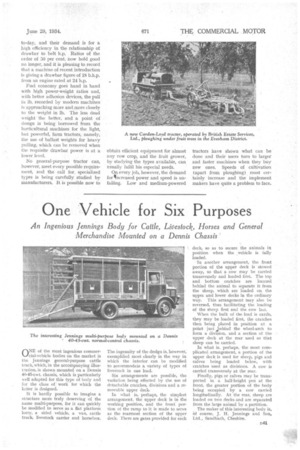One Vehicle for Six Purposes
Page 95

If you've noticed an error in this article please click here to report it so we can fix it.
An Ingenious Jennings Body for Cattle, Livestock, Horses and General Merchandise Mounted on a Dennis Chassis
QNE of the most ingenious commercial-vehicie bodies on the market is the Jennings general-purpose cattle truck, which, in the accompanying illustration, is shown mounted on a Dennis 40-45-cwt. chassis, which is particularly well adapted for this type of body and for the class of work for which the latter is designed.
It is hardly possible to imagine a structure more truly deserVing of the name multi-purpose, for it can quickly be modified to serve as a flat platform lorry, a sided vehicle, a van, cattle truck, livestock carrier and horsebox. The ingenuity of the design is, however; exemplified most clearly in the way in which the interior can be modified to accommodate a variety of types of livestock in one load.
Six arrangements are possible, the variation being effected by the use of detachable cratches, divisions and a removable upper deck.
In what is, perhaps, the simplest arrangement, the upper deck is in the working position, and the front portion of the ramp to it is made to serve as the rearmost section of the upper deck. There are gates provided for each
deck, so as to secure the animals in position when the .vehicle is fully loaded.
In another arrangement, the front portion of the upper deck is stowed away, so that a cow may be carried transversely and loaded first. The top and bottom cratches are located behind the animal to separate it from the sheep, which are loaded on the upper and lower decks in the ordinary way. This arrangement may also be reversed, thus facilitating the loading of the sheep first and the cow last.
When the bulk of the load is cattle, they may be loaded first, the cratches then being placed in position at a point just .13ehind the wheel-arch to form a division, and a section of the upper deck at the rear used so that sheep can be carried.
In what is, perhaps, the most complicated arrangement, a portion of the upper deck is used for sheep, pigs and calves being loaded below, with cratches used as divisions. A cow is carried transversely at the rear.
Finally, pigs or calves May be transported in a half-height pen at the front, the greater portion of the body being occupied by a• cow carried longitudinally. At the rear, sheep are loaded on two decks and are separated from the large animal by a partition.
The maker of this interesting body is, Of course, J. H. Jennings and Son, Ltd., Sandbach, Cheshire.
































































































































































